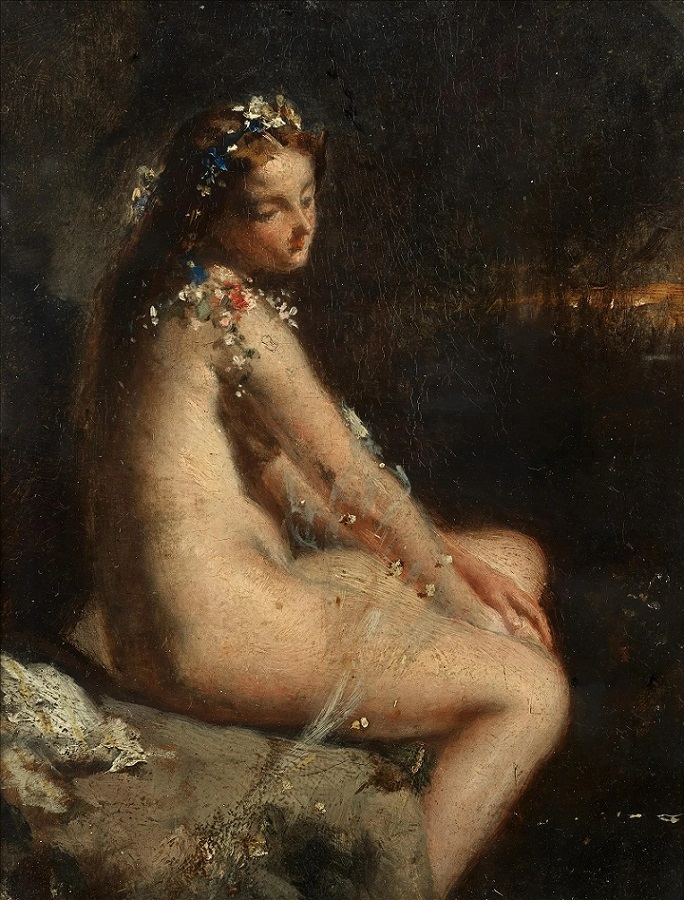William Etty, RA (British, 1789-1849)
Venus
Oil on board
19.7 x 14.3cm (7 3/4 x 5 5/8in).
Private collection
Sold for £800 in 14, 2021
William Etty, RA (British, 1789-1849)
Venus
Oil on canvas
64.5 x 50.5cm (25 3/8 x 19 7/8in).
Private collection
Sold for £2,550 in September 2022
Venus is the Roman goddess whose functions encompassed love, beauty, desire, sex, fertility, prosperity and victory. In Roman mythology, she was the mother of the Roman people through her son, Aeneas, who survived the fall of Troy and fled to Italy. Julius Caesar claimed her as his ancestor. Venus was central to many religious festivals, and was revered in Roman religion under numerous cult titles.
The Romans adapted the myths and iconography of her Greek counterpart Aphrodite for Roman art and Latin literature. In the later classical tradition of the West, Venus becomes one of the most widely referenced deities of Greco-Roman mythology as the embodiment of love and sexuality.
More on Venus
William Etty, RA (British, 1789-1849)
Venus and Cupid
Oil on canvas
70 x 47cm (27 1/2 x 18 1/2in)
Private collection
Sold for £7,650 in September 2022
%20-%20The%20Toilet%20of%20Venus.jpg)
William Etty (1787–1849)
The Toilet of Venus, between 1807 and 1849
Oil on canvas
height: 66 cm (25.9 in); width: 72.4 cm (28.5 in)
National Trust
This painting is characteristic of Etty, since many of his pictures consist of mythological characters worked up from extremely faithful studies of the female nude, drawn at the Academy Life School. Etty’s justification for painting the female nude so insistently was that he found ‘God’s most glorious work to be Woman’, and ‘that all human beauty had been concentrated in her’. Although there was much contemporary criticism of his work on the grounds of indecency, Etty was not deterred from his self-appointed task.
William Etty was a very unusual Victorian artist in dedicating himself almost exclusively to the depiction of the nude, which he painted in a glowing and sensual manner, reminiscent of Titian and Rubens. From his faithful studies undertaken at the Academy Life School, Etty produced many mythological and religious scenes, which he constantly subjected to the requirements of ideal art. More on this painting

William Etty
Venus and Cupid, c. 1830
York Art Gallery's collection
William Etty (1787–1849)
Venus of Urbino (after Titian), c. 1823
Oil on canvas
height: 122.3 cm (48.1 in); width: 169 cm (66.5 in)
Royal Scottish Academy
Different tales exist about the origin of Venus and Cupid. Some say that Venus, the goddess of love and beauty, had a love affair with Mars, the god of war. Out of this relationship, Cupid was born.
Cupid has attributes from both of his parents. Like his mother he is considered to be the god of love, or more precisely, the god of falling in love. He is portrayed as an innocent little child with bow and arrows. He shoots arrows to the heart, and awakening a love that you’re powerless to resist.
Venus and Cupid are often shown in intimate poses, reflecting the unique love between mother and child.
More Venus and Love
William Etty RA (10 March 1787 – 13 November 1849) was an English artist best known for his history paintings containing nude figures. He was the first significant British painter of nudes and still lifes. Born in York, he left school at the age of 12 to become an apprentice printer in Hull. He completed his apprenticeship seven years later and moved to London, where in 1807 he joined the Royal Academy Schools. There he studied under Thomas Lawrence and trained by copying works by other artists. Etty earned respect at the Royal Academy of Arts for his ability to paint realistic flesh tones, but had little commercial or critical success in his early years in London. More on William Etty
Please visit my other blogs: Art Collector, Mythology, Marine Art, Portrait of a Lady, The Orientalist, Art of the Nude and The Canals of Venice, Middle East Artists, 365 Saints, 365 Days, and Biblical Icons, also visit my Boards on Pinterest
Images are copyright of their respective owners, assignees or others.
Some Images may be subject to copyright
I don't own any of these images - credit is always given when due unless
it is unknown to me. if I post your images without your permission, please tell
me.
I do not sell art, art prints, framed posters or reproductions. Ads are
shown only to compensate the hosting expenses.
If you enjoyed this post, please share with friends and family.
Thank you for visiting my blog and also for liking its posts and pages.
Please note that the content of this post primarily consists of articles
available from Wikipedia or other free sources online.









%20-%20The%20Toilet%20of%20Venus.jpg)




